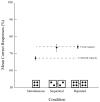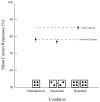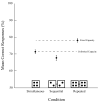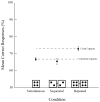The capacity limitations of orientation summary statistics
- PMID: 25810160
- PMCID: PMC4417065
- DOI: 10.3758/s13414-015-0870-0
The capacity limitations of orientation summary statistics
Abstract
The simultaneous-sequential method was used to test the processing capacity of establishing mean orientation summaries. Four clusters of oriented Gabor patches were presented in the peripheral visual field. One of the clusters had a mean orientation that was tilted either left or right, whereas the mean orientations of the other three clusters were roughly vertical. All four clusters were presented at the same time in the simultaneous condition, whereas the clusters appeared in temporal subsets of two in the sequential condition. Performance was lower when the means of all four clusters had to be processed concurrently than when only two had to be processed in the same amount of time. The advantage for establishing fewer summaries at a given time indicates that the processing of mean orientation engages limited-capacity processes (Exp. 1). This limitation cannot be attributed to crowding, low target-distractor discriminability, or a limited-capacity comparison process (Exps. 2 and 3). In contrast to the limitations of establishing multiple summary representations, establishing a single summary representation unfolds without interference (Exp. 4). When interpreted in the context of recent work on the capacity of summary statistics, these findings encourage a reevaluation of the view that early visual perception consists of creating summary statistic representations that unfold independently across multiple areas of the visual field.
Figures








References
-
- Albrecht AR, Scholl BJ. Perceptually Averaging in a Continuous Visual World: Extracting Statistical Summary Representations Over Time. Psychological Science. 2010;21(4):560–567. - PubMed
-
- Allik J, Toom M, Raidvee A, Averin K, Kreegipuu K. An almost general theory of mean size perception. Vision Research. 2013;83:25–39. - PubMed
-
- Alvarez GA. Representing multiple objects as an ensemble enhances visual cognition. Trends in Cognitive Sciences. 2011;15(3):122–131. - PubMed
Publication types
MeSH terms
Grants and funding
LinkOut - more resources
Full Text Sources
Other Literature Sources

